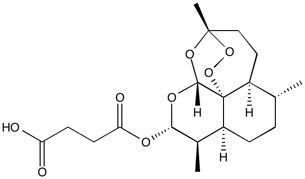Artesunate | Kills cancer stem cells / Depolarizes mitochondria
NMR (Conforms)

Available Options
| Size: | Price | Quantity | |
|---|---|---|---|
| 100 mg | $55.00 | ||
| 500 mg | $190.00 |
Artesunate (88495-63-0) is a semisynthetic derivative of the natural product artemisinin which is clinically useful for treatment of malaria and other parasitic diseases. Depolarizes mitochondrial membrane via generation of reactive oxygen species which disrupt the electron transport chain.1 Generation of mitochondrial ROS is dependent on RIP1.2 Inhibits TNFα-induced production of proinflammatory cytokines in human RA fibroblast-like synoviocytes.3 Displays cytotoxicity against a variety of cancer cells4 and cancer stem cells5.
References/Citations:
1) Li et al. (2005), Yeast model uncovers dual roles of mitochondria in action of artemisinin; PLoS Genet., 1(3) e36
2) Chauhan et al. (2017), RIP1-dependent reactive oxygen species production executes artesunate-induced cell death in renal carcinoma Caki cells; Mol. Cell. Biochem., 435 15
3) Xu et al. (2007), Anti-malarial agent artesunate inhibits TNF-alpha-induced production of proinflammatory cytokines via inhibition of NF-kappaB and PI3 kinase/AKt signal pathway in human rheumatoid arthritis fibroblast-like synoviocytes; Rheumatology (Oxford), 46 920
4) Ghantous et al. (2010), What made sesquiterpene lactones reach cancer clinical trials?; Drug. Disc. Today, 15 668
5) Subedi et al. (2016), High-throughput screening identifies artesunate as selective inhibitor of cancer stemness: Involvement of mitochondrial metabolism; Biochem. Biophys. Res. Commun., 477 737
NMR (Conforms)
Safety Data Sheet:
Product Data Sheet:
Materials provided by Focus Biomolecules are for laboratory research use only and are not intended for human or veterinary applications. Please note that we do not sell to individuals and that all orders placed by non-research organizations will incur a $20 restocking/refund fee
Artesunate (88495-63-0) is a semisynthetic derivative of the natural product artemisinin which is clinically useful for treatment of malaria and other parasitic diseases. Depolarizes mitochondrial membrane via generation of reactive oxygen species which disrupt the electron transport chain.1 Generation of mitochondrial ROS is dependent on RIP1.2 Inhibits TNFα-induced production of proinflammatory cytokines in human RA fibroblast-like synoviocytes.3 Displays cytotoxicity against a variety of cancer cells4 and cancer stem cells5.
References/Citations:
1) Li et al. (2005), Yeast model uncovers dual roles of mitochondria in action of artemisinin; PLoS Genet., 1(3) e36
2) Chauhan et al. (2017), RIP1-dependent reactive oxygen species production executes artesunate-induced cell death in renal carcinoma Caki cells; Mol. Cell. Biochem., 435 15
3) Xu et al. (2007), Anti-malarial agent artesunate inhibits TNF-alpha-induced production of proinflammatory cytokines via inhibition of NF-kappaB and PI3 kinase/AKt signal pathway in human rheumatoid arthritis fibroblast-like synoviocytes; Rheumatology (Oxford), 46 920
4) Ghantous et al. (2010), What made sesquiterpene lactones reach cancer clinical trials?; Drug. Disc. Today, 15 668
5) Subedi et al. (2016), High-throughput screening identifies artesunate as selective inhibitor of cancer stemness: Involvement of mitochondrial metabolism; Biochem. Biophys. Res. Commun., 477 737
Related Cancer Stem Cell Products
Download
Calculate the molar concentration, mass or volume in a solution.
Concentration × Volume × Molecular Weight = Mass
Focus Biomolecules • Plymouth Meeting, PA USA • 1-855-FOCUS21
Focus Biomolecules
Plymouth Meeting, PA USA
1-855-FOCUS21
Website Created by Advanta Advertising LLC.

